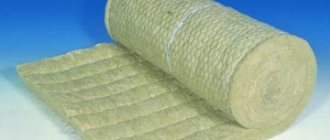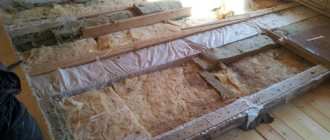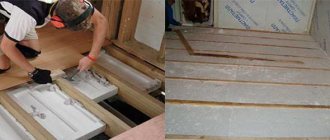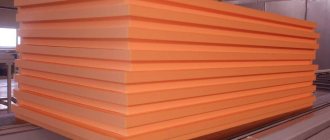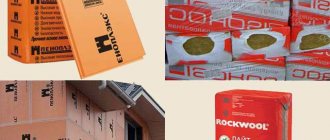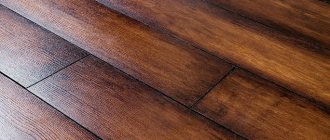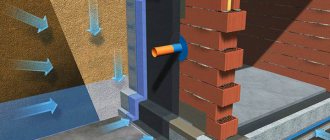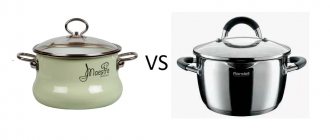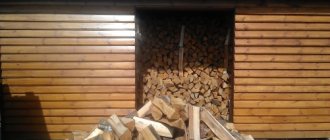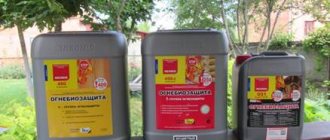The modern market for thermal insulation products is rich in assortment. However, polystyrene foam and mineral wool remain some of the most popular materials.
This is justified not only by the low coefficient of thermal conductivity and, as a consequence, excellent ability to retain heat, but also by the affordable cost, thanks to which both materials remain in demand for a long period of time.
However, when purchasing, you still have to decide, because you need to buy one thing. But since both materials have similar characteristics, this is not so easy.
Therefore, we decided to help you find the answer to the question of which is better: expanded polystyrene or mineral wool and have collected comprehensive information about both materials.
Expanded polystyrene
Expanded polystyrene is a material obtained by foaming. It consists of 98% air and 2% polystyrene with various additives. Essentially, many air bubbles are enclosed in a polystyrene shell. Since the static sealed air layer is an excellent insulator, this material is widely popular among insulation materials.
Here are some characteristics of polystyrene foam:
- The thermal insulation coefficient ranges from 0.028 to 0.036 W/(m K).
- Vapor permeability - 0.015-0.05 Mg/(m h Pa).
- It is resistant to alcohol and ether.
- Mechanical tensile strength - no less than 20 MPa.
- Soundproofing effect. A sheet of polystyrene foam 3 cm thick can reduce noise penetration by 25 dB.
- Low moisture absorption - no more than 6%.
Expanded polystyrene is produced in sheets measuring 1 m * 1 m. The thickness of the sheet can be different, depending on the needs of the buyer. The most commonly used sheets are 5 and 10 cm thick; they are also available in 3 or 2 cm thick.
Foam plastic in different sizes
However, sheets of greater thickness or different sizes can be produced to order. To increase the thermal insulation qualities, 12 cm polystyrene foam can be used.
Types of material
In addition to differences in size and thickness of the material, it is also distinguished by density. One special type is extruded polystyrene foam. It has a very fine structure and is produced by extrusion. This material has high compressive strength. It is more durable.
Extruded polystyrene foam
One of the characteristics of expanded polystyrene is density. It varies from 15 to 35 kg/m3.
Advantages
Here are some reasons why polystyrene foam is preferred to mineral wool in certain cases:
- If polystyrene foam needs to be plastered (this applies to façade finishing), it is much more convenient to work with it rather than with mineral wool. It is much easier to glue sheets of foam plastic evenly due to their smooth surface, and when applying the adhesive mixture, it will not roll off.
- Polystyrene foam is safe for health. When working with it, you do not need to use a respirator, long sleeves and glasses, as is necessary when working with mineral wool.
- Polystyrene foam has a low water absorption coefficient.
- Low price.
- Light weight.
Flaws
In addition to the advantages, polystyrene foam also has disadvantages:
- It is susceptible to rodents and other animals. If the material is not protected from external influences (for example, by plastering), mice can chew it. Another pest is geese, which can significantly damage an unplastered façade.
- Flammability. If a fire occurs, it will help the fire spread by slowly smoldering. And the substances that are released when polystyrene foam burns are very harmful to health.
- It is vapor-tight, so to maintain a comfortable microclimate in the room you will need to ventilate frequently.
- Foam plastic is negatively affected by the sun's rays - it begins to collapse. An unplastered facade can become 0.5 cm thinner over a few years.
Therefore, when choosing polystyrene foam, you should weigh the pros and cons.
Let's compare materials
To decide which material to use, you need to understand what is the advantage of one of them over the other and vice versa.
- Fire resistance. In comparison, mineral wool wins in terms of fire resistance. It does not burn even at high temperatures. Therefore, in places where there is an increased risk of fire, it is best to use mineral wool. For example, this may concern the insulation of a boiler room.
- Quality of thermal insulation (thermal conductivity). What will be warmer - polystyrene foam or mineral wool? If we compare both of these materials, we can say that 8 cm of polystyrene foam replaces 10 cm of mineral wool. Therefore, for maximum insulation efficiency, it is worth using expanded polystyrene. It holds heat better. Moreover, due to its lighter weight, it will not create a large load on the foundation of the structure.
- Ease of installation. It is much easier to work with foam plastic, since this material is safer. When working with mineral wool, you must use all protective equipment: gloves, goggles, respirator. It is also necessary to wear trousers and long sleeves. Mineral wool fibers entering the body through the respiratory tract cause severe irritation; polystyrene foam has no such drawback.
Facade insulation
- Ease of plastering. If we are talking about insulating a facade using a wet method, it is better to use polystyrene foam, since the adhesion of glue to polystyrene foam is much better than with mineral wool, this will allow plastering to be completed quite quickly. It is also easier to glue foam sheets evenly, and this will affect the quality of the facade.
- Susceptibility to rodents. Here mineral wool has an advantage. Foam can be chewed by mice, and in rural areas geese also pose a threat to the material - they simply eat it. Therefore, in order to protect the insulation, it must be plastered.
- Water absorption. Mineral wool absorbs moisture well and at the same time its thermal insulation properties are lost. When insulating open areas with mineral wool, they must be protected with a layer of glue or film until the first rain. If a large amount of water gets on the material, it will significantly reduce its quality. Therefore, thinking about this point, it is worth choosing polystyrene foam.
- Vapor permeability. Mineral wool is able to maintain a good indoor microclimate, while foam plastic practically does not allow air to pass through.
- Price. If you choose the same thermal insulation parameters, it turns out that polystyrene foam is more expensive than mineral wool, so it is better to give preference to the latter.
Having examined the advantages and disadvantages of both materials in comparison, we can come to the conclusion that there is no clear answer to the question of which is better. Each one is good in its own way. Therefore, it is worth deciding what material to use based on which part of the building is planned to be insulated.
Mineral wool
Mineral wool has a fibrous structure. Fiber thickness is from 4 to 15 microns, length is from 15 to 50 mm. The fibrous structure does an excellent job of dampening sound waves.
There are:
- Glass wool.
- Stone.
- Slagovat.
Mineral wool in slabs
The thermal conductivity of mineral wool is 0.040 W/m*°C. Therefore, the answer to the question: what is warmer - mineral wool or polystyrene foam - can be answered with polystyrene foam. Although, of course, a lot depends on the thickness and density of the material.
Types of mineral wool
Mineral wool is used in various areas of insulation; the material is available in different forms:
- Rolled. It is spread on horizontal surfaces that are insulated, or attached with staples to vertical surfaces to prevent rolling.
- Slab. It is stiffer and heavier and is not prone to rolling. The most common slab shape is 60*120 cm.
Mineral wool in rolls
Advantages
Among the advantages of mineral wool, the following points are worth noting:
- It doesn't burn. Therefore, if a fire occurs, it will not contribute to its spread.
- Mineral wool is not susceptible to pests such as mice or other animals.
- It does not emit toxic substances at temperatures up to 650°C.
Flaws
Here are some disadvantages of mineral wool:
- It is unsafe, so you need to wear a respirator, gloves and long sleeves when working with it.
- Mineral wool is hygroscopic. If rain falls on the material before it is protected, its thermal insulation properties will be significantly reduced. Therefore, when insulating a facade with mineral wool, it is advisable to immediately protect it.
Heat loss resistance
What is better to insulate a balcony - polystyrene foam or mineral wool? Having examined the heat-insulating properties of the two materials, we come to the conclusion that polystyrene foam has no equal in this characteristic.
Many insulation materials, including mineral wool, are inferior to it. And this is despite the fact that the thermal conductivity values of the two materials we are considering have almost the same values. The fact is that the internal structure of polystyrene foam is a huge number of closed cells filled with air.
This structure promotes good heat retention. Mineral wool does not have closed cells. This helps warm air escape from it.
So what holds heat better - mineral wool or polystyrene foam? The conclusion is clear. Polystyrene foam, even one that is not of the highest quality and price, is better used as a heat insulator than mineral wool.
Comparison of characteristics
When comparing which insulation is better, polystyrene foam or mineral wool, let’s consider several basic technical and operational characteristics:
- environmental cleanliness;
- thermal conductivity;
- lifetime;
- ease of installation;
- resistance to biological effects;
- price;
- insulation density;
- water absorption;
- strength;
- Fire safety;
- soundproofing properties.
Which is more environmentally friendly?
Under normal operating conditions, both insulation materials are absolutely harmless to human health. But with increasing temperature, and even more so when exposed to an open flame, polystyrene foam can become dangerous.
When polystyrene melts, the active release of toxic and poisonous gases begins. And therefore, in most European countries, the use of PPS boards for insulation is prohibited by law. Although in our country it is used everywhere.
Which retains heat better?
Both insulation materials have excellent thermal insulation characteristics. But if we compare the thermal conductivity coefficients, we can say for sure that polystyrene foam is a more effective insulation material.
Which is cheaper?
The cost of basalt mats ranges from 1400 to 2300 rubles/m3. Expanded polystyrene is sold for 1900-2300 rubles/m3, i.e. the price is almost the same. But, as mentioned above, polystyrene foam is warmer and will require 40-50% less of it. It turns out that PPS slabs are cheaper than mineral wool.
Which will last longer
When considering the technical characteristics, it was already said that the service life of PPS slabs is 25, and that of basalt wool is 50 years. Here the clear leader is cotton wool. However, when choosing insulation, you should take into account the finishing method used. Thus, a facade plastered using the “wet” method will last no more than 25 years. Therefore, the use of expensive durable cotton wool simply loses its meaning.
The easier it is to insulate
The installation technology for both insulation is identical. The insulation is initially placed on glue and then additionally secured with plastic mushroom-type nails.
What is less attractive to pests
Both polystyrene and mineral wool are not susceptible to mold and mildew. But rodents very willingly make burrows in polystyrene foam, which is significantly inferior in this regard to basalt fibers.
Which material is more harmful to health?
Under standard operating conditions, both materials are not harmful to humans. However, when the ambient temperature rises or an emergency situation occurs (fire), the foam becomes extremely dangerous for humans.
In the heat, it releases harmful styrene, which accumulates in the body, and in the event of a fire, toxic substances that can quickly render people unconscious in a room on fire. Therefore, the Stockholm Convention on Hazardous and Poisonous Substances directly prohibits the use of foam plastic for attic insulation. In Russia little attention is paid to this, but in the West there is a categorical ban.
Conclusion: under standard operating conditions, both materials do not pose a health hazard. However, you should refrain from insulating walls with foam plastic from the inside of the apartment (house) in the nursery and kitchen, where the risk of fire is higher than in other rooms. And also do not put your health at risk when insulating the attic. Here basalt wool has no competition.
Resistance to microorganisms and rodents
Both types of insulation do not serve as a basis for the growth of mold and mildew. But their relationship with mice and rats is different: they avoid basalt, and polystyrene foam serves as their favorite habitat. Nests are made in it. Adding special additives to expanded polystyrene does not solve the problem.
Conclusion: basalt wool is completely protected from adverse biological effects. Polystyrene foam should not be used where there is a high probability of mice and rats (dacha).
What's worse is burning
Basalt wool belongs to class NG (non-flammable materials), and polystyrene foam belongs to class G3 (normally flammable). Attempts by manufacturers to reduce the flammability class have been successful. Products from BASF, Polimeri Europa, Styrochem, etc., after the introduction of fire retardants, go into class G1 (self-extinguishing). Most Russian manufacturers are unable to do this, which is most likely due to semi-handicraft production.
Conclusion: basalt wool, unlike polystyrene foam, does not burn. Therefore, if there is a high risk of fire, it is better to avoid polystyrene foam.
Vapor permeability
The vapor permeability indicator is especially important when insulating wooden walls. They actively “breathe”, regulating the water balance inside the log or timber. Blocking the wood's ability to remove excess moisture with vapor-tight insulation provokes rotting processes. During the hot season, the tree does not rot, but rots. To a lesser extent, but the above is also true for brick and concrete - condensation forms on the surface of the wall, followed by the growth of mold or mildew.
Comparing the vapor conductivity of basalt (about 0.3 mg/(m.h.Pa)) and polystyrene foam (0.03 mg/(m.h.Pa)), it should be noted that they have exactly opposite properties: polystyrene foam is practically vapor-proof, while basalt wool allows the walls to breathe.
Conclusion: the vapor-tight properties of polystyrene foam give a huge advantage to cotton wool: it can be used on any type of wall material. The use of polystyrene foam is undesirable when insulating the walls of a wooden house, and when insulating brick and concrete, it is necessary to calculate the dew point so that it does not end up on the surface of the wall. If such calculations are not carried out, then the problem can be solved by increasing the thickness of the thermal insulator layer (you need to bring the dew point inside the insulation, where there will be no harm).
Which is easier to install?
Insulation of a building with polystyrene foam and basalt wool is carried out using similar technologies, which does not provide an advantage to any of the types under consideration.
Conclusion: the technology of thermal insulation by any of the materials being compared does not give any of them any advantage.
Other criteria
When choosing insulation, it is recommended to pay attention to such comparative qualities as:
- polystyrene foam is much lighter than mineral wool;
- expanded polystyrene absorbs moisture less and does not lose its properties when wet;
- basalt mats have greater bending strength, which makes it possible to insulate surfaces with complex configurations;
- the fire protection characteristics of polystyrene foam are significantly lower than those of its competitor;
- Polystyrene has virtually no vapor permeability.
Advantages and disadvantages
So, let's compare two insulation materials and find out which is better, polystyrene or stone wool. To begin with, we will determine the quality indicators of each material, after which we will move on to a more detailed comparison of individual characteristics.
Mineral wool and expanded polystyrene are completely different in manufacturing technology and internal structure. Basalt mats are obtained by melting and fluffing natural stone, and EPS slabs are obtained as a result of a chemical reaction.
Extruded polystyrene foam
This type of foam is made by foaming styrene and forming flat rectangular slabs in an extruder. The structure of the finished products is porous and consists of 96-98% of small voids filled with carbon dioxide with a small amount of air, as a result of which expanded polystyrene becomes an effective insulation.
General characteristics:
- thermal conductivity coefficient – 0.028-0.042 (W/m*K);
- moisture absorption when immersed in water for a day – 2-4%;
- compressive strength when reaching 10% deformation – 0.05-0.2 MPa;
- mechanical bending strength – 0.07-0.35 MPa;
- density – 20.0-50.0 kg/m3.
The difference in indicators is associated with different brands of PPP produced. Higher performance refers to denser and stronger material.
Pros:
- excellent insulating qualities, increasing with increasing foam density;
- long service life reaching 50 years;
- operating temperature range from -50°C to +75°C (with a maximum permissible +160°C);
- flame retardant ability;
- low cost;
- easy installation (using glue and plastic nails);
- low density, which does not weigh down building structures;
- inertness to the effects of cement-based liquid solutions;
- good adhesion to plaster solutions and paints and varnishes;
- is not affected by mold and mildew even with constant exposure to moisture.
Minuses:
A serious disadvantage of PPS boards is the need to test the material for flammability. The fact is that some of these foam plastics are capable of fire and belong to class G3. However, the addition of fire retardants transfers polystyrene to class G1 - self-extinguishing materials.
Therefore, when purchasing, you need to take a piece of the stove and set it on fire. The combustion should stop after 4-5 seconds. If this does not happen, then such thermal insulation cannot be used to insulate the facade.
In addition, critics of PPS slabs note:
- release of styrene when heated above 30°C and the absence of a continuous surface coating;
- release of hydrocyanic acid, phosgene and other toxins when melted under the influence of an open flame;
- ability to be destroyed under the influence of certain types of paints and glue;
- ability to resonate and transmit noise and vibration vibrations;
- aging under the influence of solar ultraviolet radiation.
Polystyrene foam is one of the favorite materials for rodents. Therefore, the lower part of the thermal insulation coating must be additionally protected from their influence.
Basalt wool
To form mineral wool slabs, thin fibers obtained from molten basalt are used, which are fluffed with a strong air flow. After this, the mass of fibers is compressed by a press until the required density is obtained. The result is insulation with:
- thermal conductivity coefficient – 0.035-0.045 (W/m*K);
- moisture absorption when immersed in water for 24 hours – 1-2%;
- compressive strength when reaching 10% deformation – 8-60 kPa;
- mechanical bending strength – 0.12-0.16 MPa;
- density – 30-40.0 kg/m3.
Several brands of mats made from basalt fibers are produced, which is responsible for the variation in the given technical characteristics.
Positive traits:
Among the main advantages of mineral wool, experts note:
- durability exceeding 50 years, but this is only a statement by the manufacturers, since the production of the material lasts no more than 25 years;
- excellent thermal insulation qualities;
- non-flammability and ability to withstand heating up to 1100°C;
- lack of hygroscopicity;
- resistance to aggressive chemicals;
- high elasticity;
- environmental cleanliness and safety;
- simple installation technology;
- resistance against fungus, mold and rodents.
Flaws:
The main disadvantage of basalt mats is the high cost associated with high energy consumption during its production. In addition, it should be noted that there is a large amount of dust generated during the installation of the thermal insulation layer.
What is better to insulate with polystyrene foam?
This material has proven itself very well in places where air humidity is quite high but insulation is required.
- Foam plastic will not do anything when in contact with wet ground, so it can perfectly insulate foundations, as well as various engineering structures located underground. Tens of years will pass, and the insulation will remain the same as at the very beginning. It is often used in the construction of multi-layer foundations as a middle layer. It turns out to be a very reliable and high-quality foundation.
- When building houses without basements, on a monolithic foundation, it is also convenient to use polystyrene foam. Plates of this material are laid on a leveled area, and then a layer of concrete is poured on top of them. The slabs themselves can be either one row or several. After the concrete has hardened, the walls of the house begin to be erected.
- To prevent the foundation of the house from freezing, it is very effective to insulate not only its vertical, but also its horizontal part with polystyrene foam. Expanded polystyrene slabs are laid along the foundation. Then they are backfilled, if necessary, additionally laying a waterproofing layer. This method of insulation reliably protects the foundation from frost.
- The walls of houses (both inside and outside) can also be effectively insulated with polystyrene foam. It is best if these walls are block or brick. A high thermal insulation effect is achieved when using polystyrene foam to insulate interior spaces, and the formation of a dew point is not observed.
- For non-ventilated roofs (warm, flat roofs), the PSBS grade of expanded polystyrene is used. A waterproofing layer must be placed on top. For cold roofs that are ventilated, thermal insulation is carried out differently. The inside of the roof is insulated with polystyrene foam, leaving space for ventilation. This prevents water vapor from condensing.
- It is also good to insulate floors and ceilings between floors with foam boards. A layer of insulating material is placed under them, and concrete is poured on top.
- A variety of packaging is also made from polystyrene foam, and it is also used for thermal insulation of refrigerators, freezers and special isothermal vans.
The best manufacturers on the market
One of the first manufacturers to enter the Russian market with offers of mineral wool insulation is URSA. Later, products from Knauf, Rockwool, and Isover appeared. These manufacturers are still considered the best. Analogs from other companies are cheaper, but the quality may not be for the better.
Trusted manufacturers
The most famous manufacturers of extruded and conventional foam plastic today are Penoplex, Elite-Plast and TechnoNIKOL. Any of the presented brands guarantees decent quality insulation based on polystyrene foam.
What is better to insulate with mineral wool?
- For wooden houses you don’t have to choose which is better - polystyrene foam or mineral wool. “Breathing” wooden walls cannot be insulated with foam plastic - this will negate their beneficial properties. Therefore, they are insulated with mineral wool. And in buildings built from other materials, partitions, floors, ceilings, and ceilings are sheathed with mineral wool. If external walls are insulated, then a ventilated façade of a suspended type is made. Vapor barrier membranes are an integral part of this design.
- Mineral wool is used to insulate attics, attics and floors of houses, and pitched roofs. At the same time, be sure to leave space for ventilation.
- Brick houses with a small number of floors, in which the middle thermal insulation layer is mineral wool. It is also used for three-layer panels made of concrete, reinforced concrete, as well as sandwich panels in a metal shell.
- They are used in places where it is necessary to provide good protection from very hot objects, since basalt wool can withstand temperatures up to 1000 0C.
- Frame buildings of any type are best insulated with mineral wool. In addition, it is also used for sound insulation. Moreover, this material is well suited for horizontal, vertical, and curved surfaces.
- Mineral fiber wool, produced in the form of soft slabs, can be used to wrap heat, water and gas pipes. It is also used to insulate industrial equipment in enterprises.
Professional advice on choosing insulation
The problem of choosing between polystyrene foam and mineral wool insulation for insulation often arises. Below there are two useful tips that can help even a beginner make a quick decision:
- basalt wool is suitable for thermal insulation of various facades before finishing, thermal insulation of gables, the main thing is to provide vapor and waterproofing;
- polystyrene foam is relevant for thermal insulation of facades of brick and wooden houses.
You can always reconsider your options and choose a building material that is suitable in terms of cost and characteristics.
The given recommendations serve as the result of an economic calculation and have been verified empirically. For each specific situation, a heat insulator is selected separately - it is recommended to take the advice of experienced consultants in construction stores.
Video description
How to properly insulate the external walls of a house with penoplex, watch the video:
Therefore, to insulate the walls of a house from the outside, the best choice would be to use pegopolystyrene. Due to the lack of ability to absorb moisture, this material will last a long time without the use of additional construction membranes.
Therefore, when choosing the best way to insulate the walls of a house from the outside, penoplex or mineral wool, the best choice for insulating facades will be the use of PPS. Due to the lack of ability to absorb moisture, this material will last a long time without the use of additional construction membranes.
Mineral wool is used to insulate the facade of a private house or outbuilding in cases where it is possible to install a special sheathing. Often, insulation of this kind is combined with the installation of siding, since sheathing is also needed to prepare the walls. Therefore, when choosing stone wool or polystyrene foam, which is better for insulating the facade, what the exterior decoration will also matter
Hygroscopicity
Hygroscopicity is the ability of something to absorb water. It is measured as a percentage of absorbed moisture per day relative to its own weight.
This factor determines the scope of application of the insulation. If the indicator is high, it means that the material needs additional insulation from moisture.
| Material | Hygroscopicity |
| Styrofoam | 1% |
| EPS (extruded polystyrene foam) | 0,04% |
| Mineral wool | 1,5% |
What is better to use for foundation insulation?
The construction of the foundation of a house is often associated with the need to insulate it. If the walls of a private house are well insulated, but the foundation and floor of the first floor are cold, then heat leaks are inevitable, as well as a violation of the comfortable atmosphere in the house. A foundation protected from heat loss provides:
reducing home heating costs;
Insulation of the foundation is possible in two options. The first is placing a heat-insulating layer around the perimeter of the house on top of the foundation.
The second is used in the process of making the foundation. If the installation is made of concrete, then at the pouring stage you can add a layer of insulation, thereby ensuring the installation of a warm circuit along all surfaces of the house that are at the temperature limit. Since pouring concrete involves so-called “wet” work, a material that is resistant to moisture absorption will be required. The best solution would be to use polystyrene foam or polystyrene foam. It is this insulation that will be able to retain heat in the house without losing its performance properties when in contact with an aggressive humid environment. Stone wool is not suitable for these purposes: during installation it may lose its shape, which will lead to a decrease in performance properties. In addition, during installation, moisture can get inside, which will lead to damage to the material.
There is another possible option: liquid polyurethane foam. This material is flexible and does not leave cracks or gaps.
Along with insulation, liquid polyurethane foam additionally protects the foundation from moisture. It is enough to apply a layer of 5 cm to ensure reliable protection of the foundation from precipitation. But there are also disadvantages: the high cost of the material, and the need to apply it using special equipment
Optimal use of each type of thermal insulation
Depending on the purpose and design features, certain thermal insulation options are appropriate. For example, in low-rise brick houses, as well as in three-layer concrete panels, it is better to use mineral stone wool as the middle thermal insulation layer
The insulator will also be appropriate for thermal insulation in wooden houses, where it is important to use “breathable” materials. In addition, you can save heat using mineral wool:
- in attics and pitched roofs;
- in attics and ceilings;
- in rooms with very hot appliances and a risk of fire;
- in pipeline systems and heating mains;
- frame buildings of any type.
Expanded polystyrene boards are used for insulation and sound insulation:
- in brick and block structures to eliminate the risk of dew point;
- foundations and underground engineering structures in contact with wet soil;
- horizontal part of foundations with a layer of waterproofing under operating conditions at low temperatures;
- floor coverings and areas between floors with concrete screed;
- non-ventilated roofs with a layer of waterproofing;
- freezers, isothermal vans and refrigerators.
Having studied the characteristics of expanded polystyrene and mineral stone wool as insulation materials, certain conclusions can be drawn. In terms of thermal conductivity, foam plastic is definitely better in all respects, while only stone wool can compete for the title of material that removes moisture and steam. However, in a humid environment, foam plastic retains functionality better than mineral wool, although it is not able to remove moisture outside.
In terms of fire safety, both materials are dangerous, while polystyrene foam as insulation is always a risk of ignition, while mineral heat insulators burn and melt only at the highest temperatures and the inclusion of additional synthetic components. High-quality basalt wool with the most natural composition can withstand temperatures up to 1000 degrees Celsius.
Mineral wool weighs more than polystyrene foam, so it is more difficult to install. Expanded polystyrene is lighter, more convenient to cut and simply attached to the surface. The disadvantage of the latter is the joints and possible cold bridges, which are excluded when choosing mineral wool.
One way or another, you need to choose expanded polystyrene or stone mineral wool for insulation from trusted manufacturers, taking into account the purpose of the structure. High-quality foam plastic is slabs with uniform polyhedrons securely fixed to each other, while low-quality insulation is easy to distinguish by the balls interlocking with each other.
Mineral insulation materials must have relatively high densities and a special arrangement of fibers that eliminates increased looseness of the material, which indicates a low level of quality.
Soundproofing
- Mineral wool, due to its weight and specific structure, has excellent sound dampening ability. By using it to insulate walls, the acoustic comfort in the room also improves. Therefore, mineral wool is often used in the construction of internal partitions, for example, made of plasterboard. Mineral wool slabs, which have the lowest density, are fluffier, well insulate sound traveling in the air, while hard and semi-solid slabs suppress noise caused by the operation of appliances well.
- Expanded polystyrene has mediocre acoustic characteristics, especially when it comes to sounds traveling through the air and vibrations emanating from devices. It should be noted that there are special types of polystyrene that dampen impact sounds.

